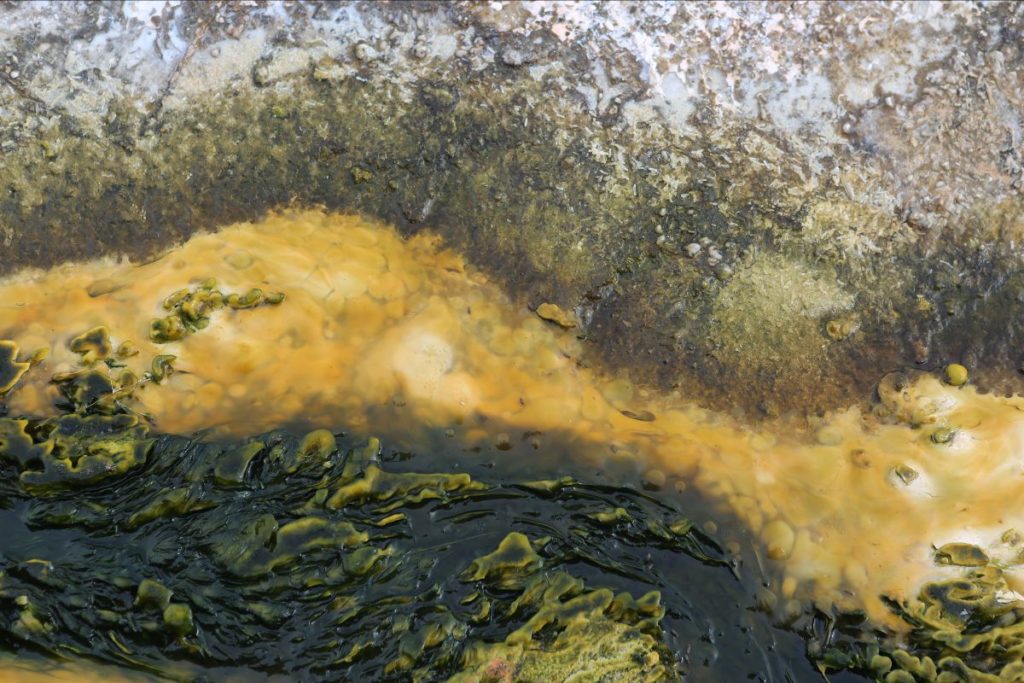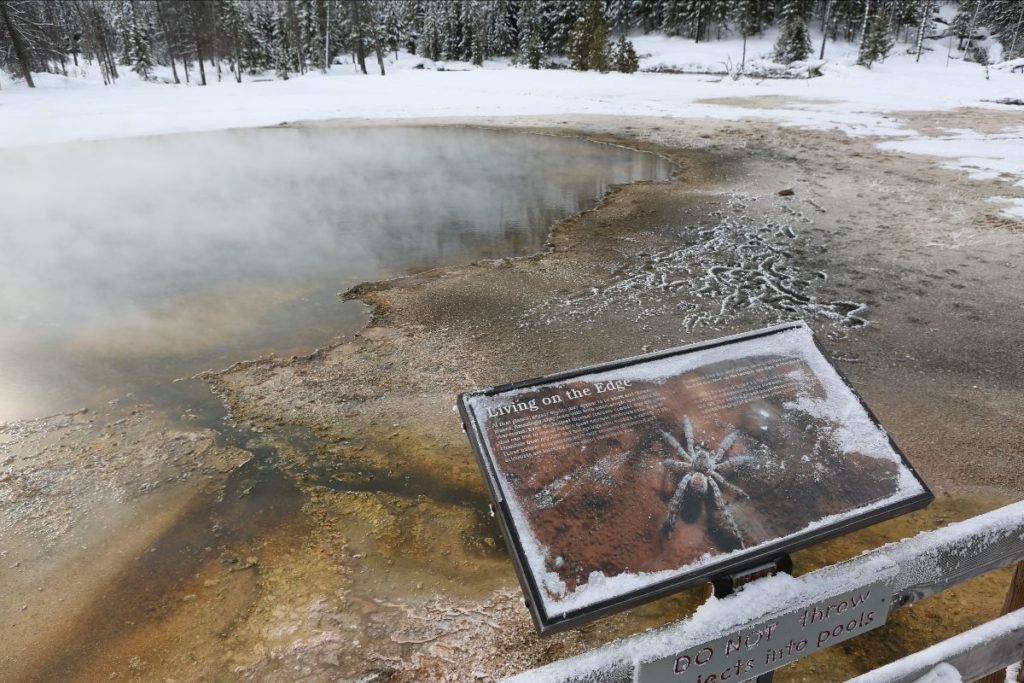Many consider insects to be the most successful lifeforms on the planet. If you’re a longtime reader of Notes from the Lab, it should come as no surprise that they can turn up in the most unexpected places.
Recently, on a trip to Yellowstone, our own museum educator Carolyn Taber witnessed some insects in a place she did not expect. While most of the park was blanketed with snow, the geothermal pools were warm, and – believe it or not – teeming with life.
The geothermal pools at Yellowstone are famous for their spectacular displays of color and power. But biology nerds know them for the unique life forms that call them home. Referred to as extremophiles, the bacteria, archaea, algae and fungal forms are some of the most unique in the world. The most famous example of a thermophilic (heat-loving) bacteria found at Yellowstone is Thermus aquaticus; T. aquaticus was first isolated from Mushroom Spring in 1969, and immediately became a species of interest for researchers. With the advent of modern DNA sequencing, T. aquaticus has become a crucial component of PCR (polymerase chain reaction). Researchers were able to exploit the thermostable enzymes present in T. aquaticus; without them, PCR sequencing would still be a bulky, days-long process; unlike the rapid PCR sequencing available to researchers today.
But we’re here to talk about arthropods, not bacteria. While insects cannot possibly withstand the same temperatures as the extremophile bacteria and archaea that calls the pools home (sometimes as high as 200 degrees Fahrenheit), the runoff from the geothermal features is the perfect temperature for a few species of heat-adapted arthropods. At a cool 109 degrees Fahrenheit, the runoff provides the perfect year-round habitat for bacterial and algal mats to thrive, and with them, the flies that call them home.

The flies in particular, Ephydra brucei, belong to a family known as Ephydridae, or shore flies. Flies in this family are commonly found on shorelines, as their name implies, but many species have adapted some extreme traits as well.
Adult E. brucei are found year-round wandering across the surface of the algal mats, feeding off detritus and algae. Occasionally, an individual may dive underwater. Protected by a layer of hydrophobic (water-repellent) hairs, the fly becomes encased in an air bubble which it utilizes as a personal diving bell while it combs the runoff bed in search of more food. The flies live out their entire lives on and around the algal mats; depositing clusters of pink and orange eggs on the nutrient rich mats where the larvae hatch out and feed until eventually emerging as adults themselves.
But even in this secluded enclave, the flies are subject to predation. Wolf spiders, known for their unmatched hunting capabilities and keen eyesight, will ambush unsuspecting flies by dashing across the algal mats at lightning speeds. An entire ecosystem exists within a place once considered too inhospitable for life – we just had to look a little closer.

The Yellowstone flies are not the only members of the Ephydridae family that have adapted an extreme lifestyle. The alkali fly, Ephydra hians, thrives on the shores of Mono lake, a seemingly barren alkaline lake in California that is two and a half times saltier than the ocean. The flies here exist in numbers so thick that the shoreline often appears black until a disturbance causes them to flee. Along with brine shrimp, these arthropods seem to have cornered a spot in the world entirely for themselves; but they are still subject to predation by the two million migratory birds that rely on their abundant numbers for a mid-migration snack. The larvae, which hatch and develop beneath the surface of this briny soup, were once an important food source for the indigenous Kutzadika’a, a band of Northern Paiute peoples who have called the region home since time immemorial.
Yet in a bid for the title of most extreme homes, another member of Ephydridae, Helaeomyia petrolei is the only known insect species to make its home in crude oil. Commonly known as the petroleum fly, this species was first described thriving in the La Brea tar pits, where the larvae develop entirely beneath the surface. While the larvae do not subsist on petroleum, they consume detritus and other dead insects that become trapped in the viscous substance, and inevitably consume the crude oil in the process. Yum.
The flies that occupy these alien and seemingly inhospitable ecosystems are proof positive that insects truly are the most successful animals on this planet. They’ve gone unnoticed by modern humans for some time, but as we begin to notice more and more species in the most unlikely places, it makes you wonder where else they might be hiding.